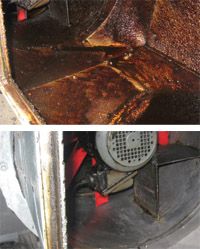Darren Ling, a director of System Hygienics, a leading air hygiene specialist, explains the importance of maintaining clean kitchen ductwork to meet legal fire safety obligations and with minimum disruption to the workplace.

Fan chamber pre-clean and post-clean
Kitchen extract systems are the perfect landing place for grease, oil, food debris and other potentially harmful bacteria. A build up of these components can cause serious safety hazards in a working environment, including bad odours, poor food hygiene, staff health issues, and the risk of fire.
Keeping canopy hoods and filters clean is the easy part, but it is the hidden parts of a kitchen extract system - the ductwork and extract fans - that pose the most serious threat. It is therefore vital to ensure kitchen extraction ductwork is properly maintained and in efficient working order to guarantee the well-being of building occupants and meet the legal requirements of The Regulatory Reform (Fire Safety) Order 2005.
Fire safety compliance
Building and facilities managers have a legal obligation to prevent the risk of fire within the buildings they manage under The Fire Safety Order (2005). Fire safety obligations include conducting a 'sufficient assessment of the risks to which relevant persons are exposed for the purpose of identifying the general fire precautions' of the building.
System Hygienics can help building and facilities managers meet their fire safety obligations by conducting a full risk assessment survey as part of its kitchen duct cleaning service.
Fire Service contract
Expelling harmful fumes and retaining a fresh flow of clean air is important in every catering environment, not just busy restaurant chains. System Hygienics recently signed a contract with West Midlands Fire Service to clean the kitchen extract systems of all its 33 sites.
A spokesperson for West Midlands Fire Service, explained: 'We take fire safety compliance very seriously as responding to fire hazards is our business. West Midlands Fire Service incorporates 30 fire stations, a headquarters, transport depot and training centre. Each of the fire stations has its own commercial kitchen and on-site chef, who cooks daily for between 10 and 15 firemen. Our headquarters and training centre have large commercial kitchens which operate a canteen service, providing a variety of meals for more than 400 staff.
'To meet our fire safety obligations we are required to carry out annual cleaning checks on the fire stations' kitchen extract systems and maintain our headquarters and training centres' kitchen ductwork twice yearly.
'Maintaining a clean working environment is something our kitchen staff take very seriously and we have rigorous procedures in place to ensure that visible surfaces are cleaned daily to avoid the build-up of grease and dirt, which could otherwise get into the extract systems.
'With our fire stations being manned 24/7, gaining building access can often present a challenge to external contractors, but System Hygienics presented a convincing business case, good quality references and was able to carry out the cleaning with minimal disruption to the running of our fire stations.
'The first phase of cleaning is now complete and System Hygienics' before and after photographic report and certification of cleanliness confirms that cleaning was achieved to an excellent standard.'
The cleaning process
The recommended method for measuring grease deposition levels in kitchen extraction ductwork is the HVCA TR19 Wet Film Thickness Test (WFTT). This incorporates using a precision gauge which is capable of measuring grease thickness from 25 to 500 microns and has become the industry standard for determining the accumulation of grease.
System Hygienics will complete a Wet Film Thickness Test to act as a gauge for measuring the efficiency of the cleaning process, before conducting a thorough manual clean of a building's kitchen extract system. Poorly maintained systems often have limited access points and are only cleaned as far as can be reached. To achieve an effective clean, access openings are generally required at three metre intervals or at each change of direction in the ductwork.
System Hygienics will identify current access points in a building's kitchen ductwork and, if required, install additional access doors in order to carry out a deep clean of the entire system. There is no leakage of grease or other contaminants, and cleaning is achieved quickly and efficiently.
To complete the clean, a further Wet Film Thickness Test is carried out and a detailed report is produced, incorporating before and after photos and a certificate of cleanliness, to offer customers peace of mind.
Section seven of the HVCA
Guide to Good Practice TR/19 Internal Cleanliness of Ventilation Systems, offers professional kitchen extract cleaning providers comprehensive advice on how kitchen extract systems should be cleaned and maintained, and includes guidelines on recommended cleaning methods, frequency of cleaning and verification of cleanliness.
In addition, the DW/172
Specification for Kitchen Ventilation Systems, also published by the HVCA, offers more detailed advice on the design, installation and maintenance of kitchen ductwork.
When commissioning maintenance work, building and facilities managers must employ highly trained, competent maintenance contractors who are able to give evidence of their skills and prove that they can carry out work to TR/19 standards.
System Hygienics
01323 481 170